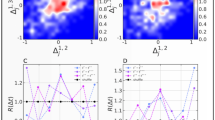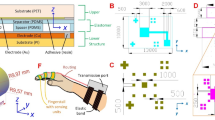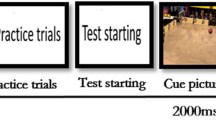Abstract
In cricket, a batsman watches a fast bowler's ball come toward him at a high and unpredictable speed, bouncing off ground of uncertain hardness. Although he views the trajectory for little more than half a second, he can accurately judge where and when the ball will reach him. Batsmen's eye movements monitor the moment when the ball is released, make a predictive saccade to the place where they expect it to hit the ground, wait for it to bounce, and follow its trajectory for 100–200 ms after the bounce. We show how information provided by these fixations may allow precise prediction of the ball's timing and placement. Comparing players with different skill levels, we found that a short latency for the first saccade distinguished good from poor batsmen, and that a cricket player's eye movement strategy contributes to his skill in the game.
This is a preview of subscription content, access via your institution
Access options
Subscribe to this journal
Receive 12 print issues and online access
$259.00 per year
only $21.58 per issue
Buy this article
- Purchase on SpringerLink
- Instant access to full article PDF
Prices may be subject to local taxes which are calculated during checkout






Similar content being viewed by others
References
Regan, D. Visual judgements and misjudgements in cricket, and the art of flight. Perception 21, 91–115 (1992).
McLeod, P. & Jenkins, S. Timing accuracy and decision time in high-speed ball games. Int. J. Sport Psychol. 22, 279–295 (1991).
McLeod, P. Visual reaction time and high-speed ball games. Perception 16, 49–59 (1987).
Bootsma, R. J. & van Wieringen P. C. W. Timing an attacking forehand drive in table tennis. J. Exp. Psychol. Hum. Percept. Perform. 16, 21–29 (1990).
Regan, D. & Gray, R. Visually guided collision avoidance and collision achievement. Trends Cogn. Sci. 4, 99–107 (2000).
Hallett, P. E. in Limits of Vision (Vision and Visual Dysfunction) Vol. 5 (eds. Kulikowski, J. J., Walsh, V. & Murray, I. J.) 44–80 (Macmillan, Basingstoke, UK, 1991).
Ripoll, H., Fleurance, P. & Cazeneuve, D in Eye Movements: From Physiology to Cognition (eds. O'Regan, J. K. & Lévi-Schoen, A.) 616–617 (Elsevier, Amsterdam, 1987).
Land, M. F. & Furneaux, S. The knowledge base of the oculomotor system. Phil. Trans. R. Soc. Lond. B 352, 1231–1239 (1997).
Bahill, A. T. & LaRitz, T. Why can't batters keep their eyes on the ball. Am. Sci. 72, 249–253 (1984).
Lewes T. MCC Masterclass: the New MCC Coaching Book (Weidenfeld & Nicholson, London, 1994).
Lee, D. N., Young, D. S., Reddish, P. E., Lough, S. & Clayton, T. Visual timing in hitting an accelerating ball. Q. J. Exp. Psychol. A 35, 333–346 (1983).
Land, M. F. Eye-head coordination during driving. IEEE Proc. SMC Conf. Le Touquet 3, 490–494 (1983).
Land, M. F. & Lee, D. Where we look when we steer. Nature 369, 742–744 (1994).
Furneaux, S. & Land, M. F. The effects of skill on the eye-hand span during musical sight reading. Proc. R. Soc. Lond. B 266, 2435–2440 (1999).
Adair, R. K. The Physics of Baseball (Harper & Row, New York, 1990).
Acknowledgements
We thank J. Horwood for several months of video analysis, and to Z. Dienes for commenting on the manuscript. Support came in part from a grant from the Gatsby foundation.
Author information
Authors and Affiliations
Corresponding author
Rights and permissions
About this article
Cite this article
Land, M., McLeod, P. From eye movements to actions: how batsmen hit the ball. Nat Neurosci 3, 1340–1345 (2000). https://doi.org/10.1038/81887
Received:
Accepted:
Issue date:
DOI: https://doi.org/10.1038/81887
This article is cited by
-
The Relationship Between Environmental Statistics and Predictive Gaze Behaviour During a Manual Interception Task: Eye Movements as Active Inference
Computational Brain & Behavior (2024)
-
SOTVerse: A User-Defined Task Space of Single Object Tracking
International Journal of Computer Vision (2024)
-
Bone conductivity and spine fluoroscopy, Hand-Eye-Ear dialogue, during pedicle screw positioning: a new human cognitive system for precision and radiation-decrease; better than artificial intelligence and machine learning system?
International Orthopaedics (2023)
-
Are predictive saccades linked to the processing of peripheral information?
Psychological Research (2023)
-
Attributes of Expert Anticipation Should Inform the Design of Virtual Reality Simulators to Accelerate Learning and Transfer of Skill
Sports Medicine (2023)



